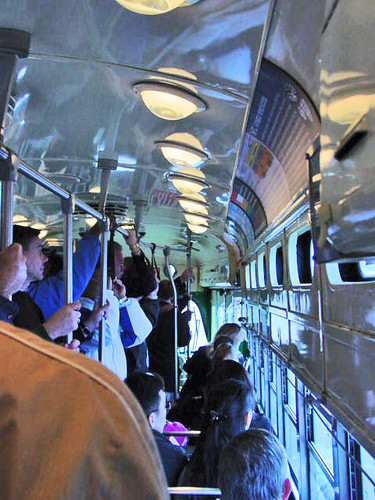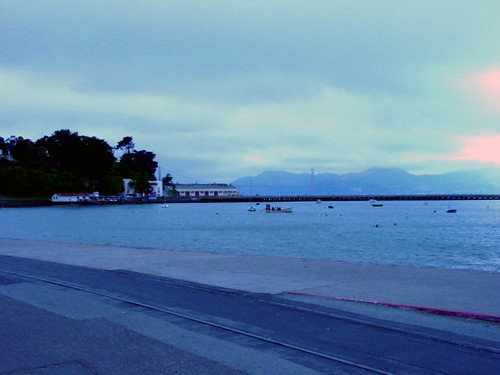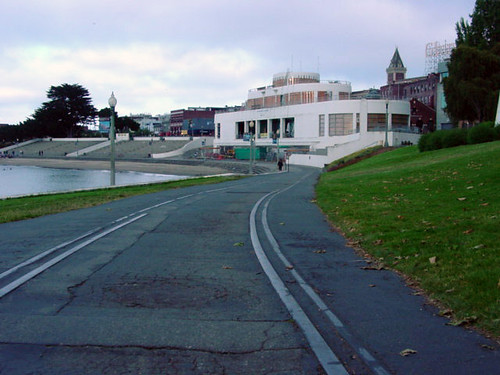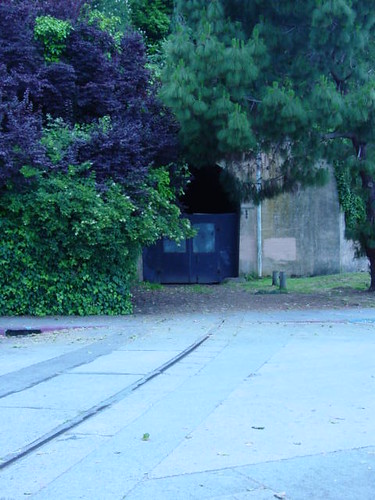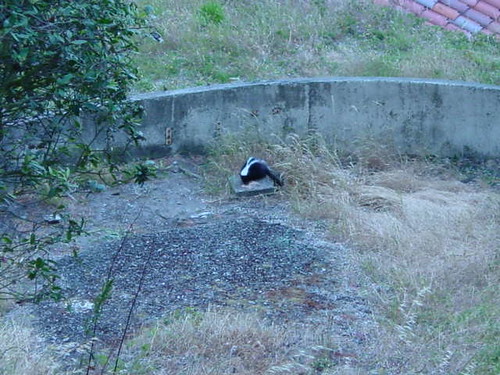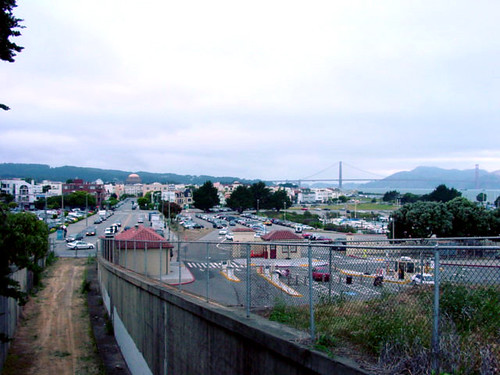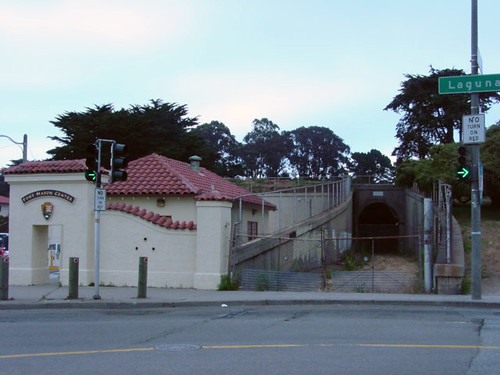Monday, April 11, 2011
Sunday, December 21, 2008
Dumb Criminals
Wednesday, July 2, 2008
What's Not to Like?
I was walking more, to and from the grocery store for example, and walking to the bank, the hardware store, library or Blockbuster rather than taking the car and I shed twenty pounds within five months. When I found that most of my pants were too large, I walked to the new thrift store and bought a new ones.
...
Frankly, the high cost of gas has improved my life.
Monday, April 21, 2008
No Party Like a Tram Party
Travelers waiting for one of Prague’s traditional trams will occasionally see something strange pull up to the station: a streetcar with a full-bore dance party taking place inside, complete with high-energy music, disco lighting and bartenders.
Thursday, April 3, 2008
More Light Rail Traffic Density Reports
Thursday, February 7, 2008
News Around the Blogosphere
Streetsblog covers the story of a man that got thrown in jail for painting his own crosswalk.
Stephen Rees discusses how privatization of the tube is leading to a £2 B pound loss now that London had to bring it back under public ownership. He states its not a result Wendell Cox will be trumpeting any time soon.
Ryan at Transit Miami busts the Hurricane and overhead wire myth.
Ben at Second Avenue Sagas reports the NYC Subway has its highest ridership since 1951.
Want more awesome blogs like these to read? Visit City Transit Advocates!
Saturday, January 12, 2008
Idea: LACMTA Turnstiles = Electricity
Another idea that came up this week sent to me by a colleague and friend was the ability to use excess body heat from subway stations to heat buildings. Sounds kind of gross to me, but if it works...
Tuesday, January 1, 2008
Happy New Year!
Friday, December 21, 2007
A Year of The Overhead Wire
Tuesday, November 27, 2007
New Blogs for the Roll
Jacksonville Transit - Transit News from Jacksonville Florida.
Light Rail AZ - Discussing Phoenix Light Rail Issues.
Light Rail in Grand Rapids - A Discussion of Grand Rapids Transit Progress.
Street Heat - LA Transportation News.
Thursday, November 1, 2007
Live Blogging from Rail~Volution
Update: 3:10 ET Effie Stallsmith is up from the Federal Transit Administration and Steve is live blogging over at Urban Review St. Louis linked above.
Update: 3:30 ET Effie discusses transportation departments taking their plans and meetings to myspace.
Steve pointed out a youtube about RSS feeds. A lot of folks know how this works so you don't have to watch it, but I thought it was of interested to folks out there who are tired of going to different sites looking for new content. Why not make it come to you?
Tuesday, October 30, 2007
Rail~Volution, Earthquakes, and Hurricanes
Tuesday, September 25, 2007
Future Posting Gaps & Budapest
This summer, Budapest put new trams in service on the world's busiest tram line, trams from the Siemens Combino family that are the world's longest trams for passengers:For me as a railfan, trams and tramways were too ordinary and everyday sights, and never considered them 'proper' railway. So I was astonished to discover that trams have plenty of afficiados among Western railfans. What's more, it turned out my (former) home city Budapest was an eldorado for them: an extensive network even after four decades of closures, lots of different tram types, lots of older types in regular traffic.
So, I thought trams deserve Train Blogging coverage, and took the occasion of the arrival of the Combinos to remedy my long dismissal by reading up on tramways, and present their development via the trams of Budapest. But when the Combinos had big technical difficulties, I delayed posting. Now I do it with a lager picture selection.
Thursday, August 9, 2007
National Transit Blogging
RT Rider: Life Saving Value of Transit
Want to stop the war? Ride the bus.
OK. That's a bit of a stretch, but everyone can agree that if America were to reduce its reliance on foreign petroleum supplies, national security would benefit.
In January of this year, the American Public Transportation Association released "Public Transportation and Petroleum Savings in the U.S.: Reducing Dependence on Oil," a study prepared for the association by ICF International, a global consulting firm that specializes in the connection between transportation and energy.
Sacramento Regional Transit's local system is part of a national effort that, according to the report's executive summary, "reduces U.S. gasoline consumption by 1.4 billion gallons each year.
Transit Miami: Stupid Legislators
Republican Patrick McHenry, an ignoramus congressman from North Carolina is attempting to hamper efforts of other congressman who are writing a provision to encourage increase bicycle use. Apparently McHenry openly opposes the paltry $1 million proposition yet he openly favors wasting Billions more in Iraq, you know, "fighting the war on terror..."
The U.S. infrastructure is falling apart McHenry, quit wasting our money building a new one in Iraq...Bikes aren't a solution, but, they are part of the puzzle...Here is an e-mail I received word for word from a loyal TM reader:Last Saturday the House of Representatives passed Energy Independence legislation that amends a section of the IRS code to include "bicycles" in the definition of transportation covered by the qualified transportation fringe benefit.Introduced earlier this year by Congressman Earl Blumenauer as H.R. 1498, the provision calls for a $20 monthly benefit for riding a bike to work.
However, according to Blumenauer, even this modest amount sparked some heated opposition — even ridicule — from other House lawmakers.
Urban Planning Overlord: Light Rail in Downtown Milwaukie
There's a tussle breaking out over the preferred location of light rail tracks in downtown Milwaukie. The original plan would use a grede-separated right of way along the existing train tracks. But the Waldorf School (next to the tracks) doesn't like the noise and wants the MAX line to use two downtown streets. The merchants don't like that idea.
Sunday, July 15, 2007
Peter A.B. Widener, Transit Mogul
A transit mogul, Widener monopolized the street railways of Philadelphia. Starting in 1875, Widener and a partner began buying transit lines, modernizing the horse drawn cars first with cable cars, then with an electric trolley system that required the repaving of the city's streets. By 1895, the system supported 100 passengers a year.What is fascinating about this is how the money was made. Before Widener and a few others pioneered the collection of utilities to operate as one, each line and lighting company were separate in different sections of the city, leading to competition and the need to pay a different fare for each transfer.

But it was these moguls who paved the streets and lit the houses in New York, Chicago and Philadelphia, however through nefarious means. Dubbed syndicates, they were the reason we have the term 'Public Utilities' :
When Thomas A. Edison invented the incandescent light, and when Frank J. Sprague in 1887 constructed the first practicable urban trolley line, in Richmond, Virginia, they liberated forces that powerfully affected not only our social and economic life but our political institutions. These two inventions introduced anew phrase--"Public Utilities." Combined with the great growth and prosperity of the cities they furnished a fruitful opportunity to several particularly famous groups of financial adventurers. They led to the organization of "syndicates" which devoted all their energies, for a quarter of a century, to exploiting city lighting and transportation systems. These syndicates made a business of entering city after city, purchasing the scattered street railway lines and lighting companies, equipping them with electricity, combining them into unified systems, organizing large corporations, and floating huge issues of securities. A single group of six men--Yerkes, Widener, Elkins, Dolan, Whitney, and Ryan--combined the street railways, and in many cases the lighting companies...Charles T. Yerkes was the driving force behind Chicago's street railway and lighting was able to control city and state government officials. However in Philly, he was imprisoned for of all things embezzlement which led him to move to Chicago and opened up the door for a City Official named Peter A.B. Widener.
It was this circumstance in Yerkes's career which impelled him to leave Philadelphia and settle in Chicago where, starting as a small broker, he ultimately acquired sufficient resources and influence to embark in that street railway business at which he had already served an extensive apprenticeship. Under his domination, the Chicago aldermen attained a gravity that made them notorious all over the world. They openly sold Yerkes the use of the streets for cash and constantly blocked the efforts which an infuriated populace made for reform. Yerkes purchased the old street railway lines, lined his pockets by making contracts for their reconstruction, issued large flotations of watered stock, heaped securities upon securities and reorganization upon reorganization and diverted their assets to business in a hundred ingenious ways.Widener stepped up after Yerkes had gotten the previous city treasurer in trouble for the embezzlement. He was also a butcher, which apparently is a pretty big deal for politics.
A successful butcher shop in Philadelphia in those days played about the same part in local politics as did the saloon in New York City. Such a station became the headquarters of political gossip and the meeting ground of a political clique; and so Widener, the son of a poor German bricklayer, rapidly became a political leader in the Twentieth Ward, and soon found his power extending even to Harrisburg.
He also picked up a bond partner in Elkins and the two came into control of Philadelphia's traction organization.
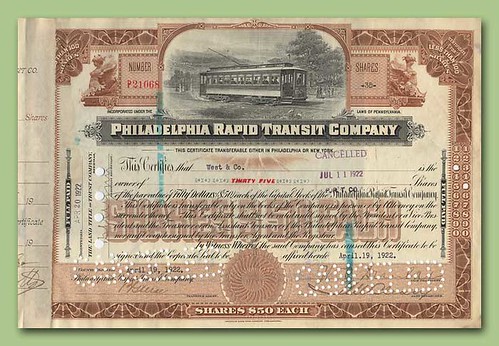
Widener and Elkins, however, not only dominated Philadelphia traction but participated in all of Yerkes's enterprises in Chicago and held an equal interest with Whitney and Ryan in New York. The latter Metropolitan pair, though they confined their interest chiefly to their own city, at times transferred their attention to Chicago. Thus, for nearly thirty years, these five men found their oyster in the transit systems of America's three greatest cities--and, for that matter, in many others also.Later on, the syndicate ended up buying the Broadway Traction Company in New York City. This led to their organization being the first holding company.
This Broadway franchise formed the vertebral column of the New York transit system; with it as a basis, the operators formed the Metropolitan Street Railway Company in 1893, commonly known as the "Metropolitan." They organized also the Metropolitan Traction Company, an organization which enjoys an historic position as the first "holding company" ever created in this country.
It's a fascinating story and the Age of Big Business is definitely a good read and as much as I want to, I can't quite cover it all without just copying and pasting the whole thing.
Friday, July 13, 2007
Transit Trading Cards

Then I got to thinking, what are the statistics for that bus? What kind of grades can it operate on? How much power is produced by the motor? Then I immediately shot back to when I was a little kid trading Ken Griffey Jr. and Craig Biggio baseball cards. I knew everyone's stats and had them memorized. I also had micro machines and my friends and I liked collecting them. My favorite was the Star Wars A-Wing fighter. I can still tell you that it can go 120 MGLT, faster than any fighter ship in the Star Wars galaxy (At the time of my last guidebook, it might have changed).

But why can't we have transit vehicles portrayed in the same way with stats and figures? Why can't we take a wikipedia entry and make micromachines out of the Siemens Combino or the S70 vehicles (which do not have a wikipedia entry)? There could be old time streetcars as well with Birney Safety Cars in a set with PCCs. Add in some historic buses. The point is that you can give younger folks, and even folks my age a reason to get excited when they see transit. Kids would know all of the streetcar types and would get excited when they saw them in cities. It would also make the city seem more interesting to kids who might never have been exposed to it living in the burbs.
The only reason I know about rapid transit is because my dad and I used to ride BART to the auto show at the Moscone Center during Christmas holiday on our visits to my grandparents house. Pop culture feeds kids cars in the form of hotwheels, power wheels and micro machines, if we want to change views of transit, we have to look at how they get into our sub conscience so early. Perhaps trading cards, perhaps hasbro?
Thursday, July 12, 2007
Siemens Combino in Budapest
But I'll make sure I pay the fare, instead of perhaps doing it the more dangerous way as seen below.
Tuesday, July 10, 2007
Rail on Daily Kos
Part 1. Local Rail
Part 2. Rapid Transit
It's an interesting series and spawned a lot of discussion when some bus oriented folks tried to spread talking points from some libertarian think tanks including the Cascade Policy Institute. My favorites included the use of Portland's stat sheet to point out that buses were better than rail in operating hours and also someone arguing on behalf of the Bus Riders Union talking points. One person went so far as to say that each LRV costs $12 million which is ridiculous.
In any event i'm going to re-post some excerpts of my comments below...
...More stats from that ridership chart (Portland, 2004) that matter... Lets look at subsidy per rider, .62 cents for rail to $1.20 for bus, the cost per passenger mile (because we are comparing two different service types) .68 cents for bus versus .29 cents per passenger mile for rail and Max carries 41% of the passenger miles!...
...his argument really revolved around the thought that you could replace a whole system with buses, but then you look at how much they cost per passenger mile and staffing those some 6,000 buses would have broken the operating bank...
...So lets look at the cost of buses versus trains in real costs...just vehicles. In 2007 your transit authority buys two LRVs for six million. It carries 464 passengers per two car consist with one driver. 60 foot articulated buses (nothing longer is legal in the US nor should it be if it is on the same streets as cars) carry 90 passengers max. So to carry the load of the LRT you need about 5 buses. Those 5 buses cost about a million each, each need a driver and have to be replaced in 12 years which means in 24 years you have spent 6 million on two LRVs and 10 million on 10 buses not to mention inflation for the 12 year bus replacement. Then, you have the costs of paving the roads, which in the case of the Orange Line in LA are already messed up (photo proof) But no one ever adds those costs in. Nor do they mention that rail attracts 34-43% more riders...
...Let's also look at energy usage...The Department of Energy Oakridge Lab puts out data every year. The most recent shows rail on top again. 4,318 BTU per passenger mile for bus versus an average of 2,978 BTU per passenger mile of any rail (Amtrak, Rapid Transit and Commuter Rail)...
And so on and so forth. Go ahead and check out Kos. If you aren't a diarist over there you might want to sign up so you can take part in the discussions. However it takes a week I believe before you can post because they don't want folks to just make up names and jump on.
Thursday, May 31, 2007
The Future E-Line to Fort Mason
Several guys from New York City came on as well. They were to get off at Pier 39 so they gave me a fiver to pay with because they couldn't get to the front. I think they trusted me after I showed them that I had a pin on my bag that had the same MSR logo that was all over the inside of the car. After paying the five and my $1.50 the driver asked me where he could get the pin as I told him the story about the New Yorkers.
So I got off and walked down to where the new line would be extended to Fort Mason. I saw the tracks in the ground left from a bygone era and was wondering how slow the streetcar would have to go or how they would allow pedestrians and streetcars along the waterfront.
From the picture above, if you turn around and walk towards Fort Mason you can see the single track tunnel that was carved out for freight to the piers
As I was walking around to the other side of the tunnel I also saw a skunk on the hill above the Fort Mason docks. It was pretty brave of this fellow to be out in broad daylight (or dark foggy evening) but nevertheless there he was. I wasn't going to mess with him but he was at a pretty good distance.
Finally as I got to the other side I could get a clear view of the Golden Gate Bridge behind the West Portal of the streetcar tunnel. This is where the streetcar will move out to the Marina giving its residents their first rail link in over 50 years. How exciting!
Monday, April 16, 2007
Cargo Trams
Zurich - Kind of a Good Will Trailer on rails. People drop off disposable items and electronics and it's taken to the recycling center to be disposed of properly. English Translations can be done here.
Amsterdam - City Cargo will use trams and electric vehicles to distribute goods in the city. This is a really promising idea for the United States if we ever rebuild some of our interurban lines. No more big delivery trucks with diesel emissions...
Dresden - Volkswagen built a spur off of the city tram line to transport car parts across the city. The tram line takes 3 trucks off the road per trip. Fascinating Stuff.
A Discussion at Portland Transport about Cargo Trams...and a Swiss Blog is following the trend.

